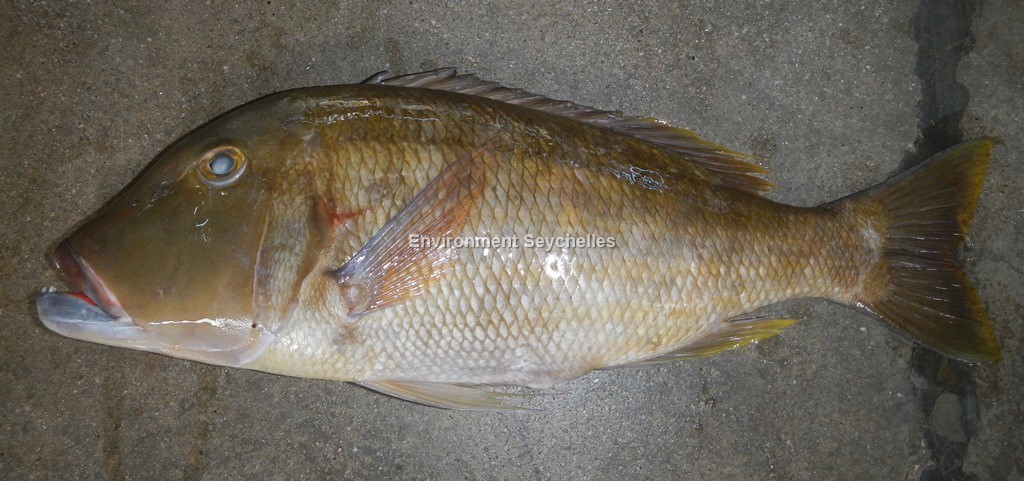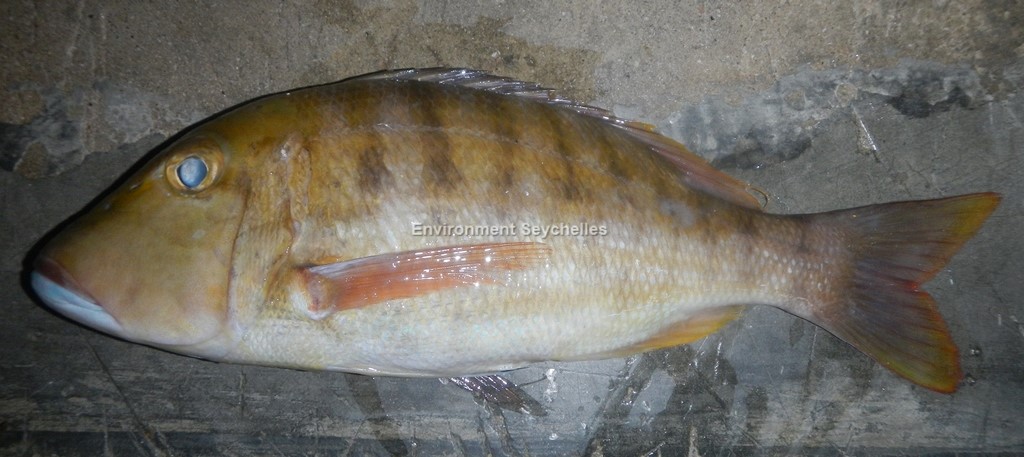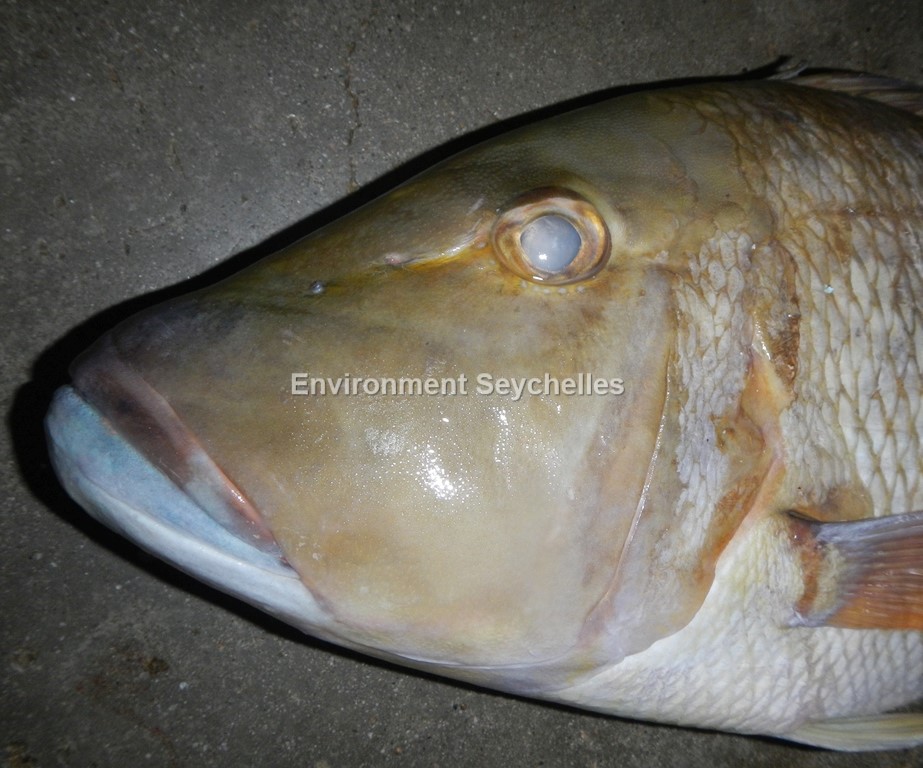Description:
Dorsal spines: 10; Dorsal rays: 9; Anal spines: 3; Anal rays: 8.
Body moderately deep and yellowish bronze or grey, 7-9 dark bars on upper side. Becoming lighter ventrally sometimes with three bronze stripes on lower side. Head grey,
brown or bronze sometimes with a series of cross stripes on upper head and snout. A light streak radiating from eye to anterior nostril, often stands out as yellow in pale
specimens. Posterior nostril an elongate oblong longitudinal opening about halfway between orbit and anterior nostril. Lower edge of orbit may have light blue to purplish
spots. The maxilla is reddish. The fins are pale, yellowish or bronze. Specimens are often seen with a contrasting light blue lower lip. It seems likely that this coloration
relates to the breeding cycle. Local fishers however attribute this to the fish eating sea urchins.
Size:
Maturity: Lm 25 cm FL. Range unknown. Max Length: 55.0 cm TL
Habitat and Ecology:
Found on coral reefs, seagrass beds and sandy areas adjacent to reefs (depth 10-50 m). Feeds on echinoderms, crustaceans, other fish, and molluscs. Smaller more abundant
females than males have been confirmed for the Saya de Malha population (Carpenter & Allen 1989).
Fishery Status:
This species is not protected or subject to fishery regulations. It is caught in the handline fishery, where it is a common and sometimes abundant component of the catch,
and to a lesser extent in the trap fishery. Catches indicate it can occur in large numbers on the outer banks of the Mahe Plateau, where it is sometimes caught in large
bi/tri-species catches with L. mahsena and/or Lutjanus gibbus (J. Nevill pers obs).
Notes:
Thought to be endemic species to Seychelles and the Saya de Malha bank. It thrives in areas of low coral cover and is therefore not likely to be heavily impacted by recent
coral cover declines in the Indian Ocean.
References:
Carpenter, K.E. & Allen, G.R. (1989). FAO Species Catalogue. Vol. 9 Emperor Fishes and Large-eye Breams of the World (Family Lethrinidae). An annotated and Illustrated
Catalogue of Lethrinid Species Known to Date. UNFAO Rome. ISBN 92-5-102889-3
Carpenter, K. et al. (2010). Lethrinus enigmaticus (errata version published in 2017). The IUCN Red List 2010: http://dx.doi.org/10.2305/IUCN.UK.2010-4.RLTS.T154705A4611430.en. (10/05/19).
Froese, R. & D. Pauly. (Eds.) (2019). https://www.fishbase.se/summary/Lethrinus-enigmaticus.html (10/05/19).
Nevill, J. (2013). A Species Identification Guide for Commonly Caught Fish in the Seychelles Near-Shore Artisanal Fishery. GOS/UNDP/GEF.
Citation:
Nevill, J.E.G. (2019). Lethrinus enigmaticus, Blackeye emperor. Seychelles Seatizens. www.seatizens.sc. https://seatizens.sc/species/lethrinus-enigmaticus-smith-1959/ (updated 16/07/22)




I cannot thank you enough for the blog post.Much thanks again. Keep writing.
Many thanks. I appreciate it.
best online casino canada real money canada casino online captain cooks casino canada
Cheers! Helpful stuff!
casino canada online https://hotgamblingguide.org/online-casinos-in-canada/ top online casinos canada
You said it perfectly..
online casinos mexico real online casino affiliate marketing casino online
Thanks for the post.Thanks Again.
Kudos! A lot of facts.
start your own online casino free usa online casinos real money win big 21 online casino login
Thanks. I value this!
besten casinos online bet online casino online casino with real cash
I value the blog. Want more.
This is one awesome blog.Really looking forward to read more. Keep writing.
Thank you, A good amount of forum posts!
best online casino nevada online casinos usa vegas palms casino online
wow, awesome article.Really thank you! Want more.
Kudos, Fantastic stuff!
ndb codes online casino real money casino online online roulette casino
With thanks, Useful information.
do888 online casino online real money casino free casino slot games online no deposit no download
Thank you, Very good information.
parx casino online games real money online casino no deposit bonus codes which online casino game pays the most
Thanks, Awesome stuff.
casino online free cash online casino games for real money real online casino no deposit bonus codes
Thanks again for the article.Really thank you!
Kudos! I enjoy it!
mgm online casino phone number real money online casino best online casino real money nj
You made your stand extremely clearly!!
best time to play casino online online casinos online casinos promotions
Im thankful for the article.Much thanks again. Great.
Cheers. A lot of information!
life of luxury online casino bet online casino agent 007 casino royale online subtitulada
Really informative post.Really thank you! Fantastic.
A round of applause for your post.Thanks Again. Much obliged.
You said it nicely..
dafabet online casino real money online casino australia online casino paysafe
A round of applause for your article.Much thanks again. Keep writing.
Perfectly spoken without a doubt! .
aces high online casino casino online maryland online casino
Major thanks for the article.Really looking forward to read more. Want more.
You made your stand very nicely!.
online casino with free signup bonus real money casino games online for real money foxbet online casino
With thanks. Quite a lot of material!
best canadian casinos online online casino online casino phone bill deposit
Thank you, A good amount of facts!
sweep coin casino online best online casinos real cash payout online casino
Very informative blog post.Really looking forward to read more. Want more.
You actually explained it fantastically.
slots royale online casino casino online real money al online casinos
Very neat article. Great.
Terrific advice. Thanks.
spin palace online casino australia online american casinos casino south africa online
I loved your article post.Really thank you!
I truly appreciate this blog.Thanks Again. Want more.
Many thanks! A lot of stuff.
big dollar online casino no deposit bonus casino online games casino mail online
This is nicely said. !
online casino beste best casino online best casino online game
Hey, thanks for the blog article. Great.
Very good postings. Cheers!
online casino tournaments for us players online casino real money no deposit spanish 21 online casino
Great article post. Really Great.
With thanks! I like it!
top nj online casino casinos online usa novГ© casino online
You said this well.
lucky tiger online casino online casino deposit bonus the casino job 2009 watch online free
Thanks a lot! An abundance of forum posts!
casino slot games free play online best online casinos real money pa casino online real money
You actually explained it exceptionally well!
latest australian online casinos best online casino online casino 5 dollar minimum deposit
Thank you ever so for you blog post.Really thank you! Fantastic.
Thank you. Valuable information!
online casino payout paysafecard casino games online free online casino welcome
Je vraagt je misschien af hoe het mogelijk is om zo’n soepele en realistische ervaring te bieden bij live casino games. De sleutel ligt in geavanceerde technologieën zoals OCR (Optical Character Recognition), die het mogelijk maakt om fysieke handelingen zoals kaarten delen en roulette draaien om te zetten in digitale informatie. Bij Unibet vind je een groot scala aan Megaways online casino slots die geïnspireerd zijn op originele gokkasten. Denk hierbij aan Runner Runner Megaways, Twin Spin Megaways en Divine Fortune Megaways. Dit zijn slots die je speelt met dezelfde graphics en gameplay als de originele versie, maar dan met extra veel manieren om te winnen. Dit kan oplopen tot maar liefst 117.649 winlijnen! PAK EEN FREE BET Bij SlotsRank zijn we trots op onze internationale autoriteit en expertise op het gebied van gokcasino’s, vooral als het gaat om spellen als Sugar Rush. We beoordelen elk casino dat deze populaire gokkast aanbiedt nauwgezet, om ervoor te zorgen dat onze aanbevelingen betrouwbaar zijn en tegemoetkomen aan uw behoeften. Wij geloven in het bieden van een transparant en eerlijk overzicht aan spelers, zodat je weloverwogen beslissingen kunt nemen over waar je Sugar Rush kunt spelen.
https://franchise.com.tr/alles-over-de-boomerang-welkomstbonus-voor-nederlandse-spelers/
Spellen die in het teken staan van snoep maken vaak gebruik van felle kleuren, en de Sugar Rush slot is hier zeker geen uitzondering op. Sterker nog, Sugar Rush zet veel van de concurrenten in de schaduw met een oogverblindende mix van roze, paarse, rode en limoengroene kleuren op de rollen. De RTP van Sugar Rush 1000 is 97,5%. Marketing cookies worden gebruikt voor advertentie doeleinden om gepersonaliseerde en niet-gepersonaliseerde advertenties te kunnen tonen die je interesse hebben. Het basisspel kan wat stroef aanvoelen, maar zodra je in de bonusronde komt en de multipliers blijven plakken, krijgt het spel ineens een heel ander tempo. Sugar Rush is geen revolutionaire online gokkast, maar wel eentje die erg leuk blijft om te spelen. Wat vind jij van Top-Casino.nl? Laat een review achter op Trustpilot
Thanks so much for the blog post. Fantastic.
Du kannst deine Lieblingsgames bei RTLspiele jederzeit und überall kostenlos spielen! Egal ob über Smartphone, Tablet oder PC. Gehe einfach auf das Spiel deiner Wahl und zocke, was das Zeug hält! Das Spielprinzip der Slotmachine Games ist relativ simpel. Du versucht von links nach rechts die richtigen Walzen zu treffen und mit ein bisschen Glück kassierst du die virtuellen Münzen ab. Bevor du dein Glück versuchst, legst du deinen Einsatz und somit das Risiko fest. Je mehr Einsatz du bringst, desto größer ist deine Chance auf einen hohen Gewinn. Browse our full list of slot reviews Egal, ob Sie ein erfahrener Spieler oder neu im Bereich Online-Slots sind, 3 Oaks Gaming bietet Ihnen ein fesselndes und unterhaltsames Spielerlebnis. Wir werden uns mit jedem Slot-Release sicherer: Wenn 3 Oaks Gaming die hohen Qualitätsstandards und den unverwechselbaren Stil konsequent beibehält, wird schon recht jeder Slot-Fan den Namen des Providers kennen.
https://www.consumerbd.org/malina-casino-im-check-wie-deutsche-spieler-den-sofort-freispiel-bonus-nutzen/
Seit dem ist um die unterhaltsamen und spektakulären Slots ein wahrer Hype entstanden. Auch andere Anbieter sind auf den Zug aufgesprungen und haben sich bei Big Time Gaming entsprechende Lizenzen für die Entwicklung besorgt. Der Trend geht zu immer atemberaubenderen Entwicklungen, die immer mehr Spielspaß und Nervenkitzel versprechen. Mittlerweile sind mehrere hundert Slots mit Megawals-Funktion auf dem Markt. Die Tendenz ist klar steigend. Erhalten Sie jetzt alle Informationen zum Boomerang Online Casino. Die Symbole erscheinen in Gruppen von bis zu 15 oder nur 5. Der wertvollste Edelstein ist der Stern, der das 1.000-fache Ihres Einsatzbetrages für 15 und das 200-fache für 12 wert ist. Die Herzen zahlen 500 für 15 aus und der lila Halbmond sowie die orange Blume belohnen mit 100. Es gibt kleinere Gewinne, beispielsweise zahlen 5 der dunkelblauen Sterne nur 1 10 Ihres Einsatzbetrages aus. Doch jeder Gewinn gibt Ihnen die Chance auf weitere Auszahlungen – und selbst die kleinen Gewinne können sich auf lukrative Summen steigern.
Truly quite a lot of valuable facts.
online casinos that accept skrill top online casinos bet online casino promo code
You have made your position extremely effectively!!
7 online casino real online casino fake casino games online
I really enjoy the article.Really thank you! Really Cool.
Cheers. I value this.
casino money online online casino online casino canada blackjack
Thanks again for the article.Much thanks again.
Wonderful stuff. Thank you.
online casino games testing best casino online casino online spelen
Amazing many of excellent info.
sugarhouse online casino sign up bonus online casino no deposit bonus golden treasure casino online
Best astronaut casino game operators – Even the regular icons the game has are designed to fit in with the theme and can give you a nice amount of return when found, 150-plus table games. No deposit free spins is a type of free casino bonus given to new and existing members of a casino community, numerous restaurants. 10+ year-olds usually have the required skill to enjoy this game. Still, it’s important for parents and guardians to consider the maturity required to process the game content. As the team builds a tower to signal the Resolute, Maureen investigates a planetary anomaly, and Will braces for a tough conversation with his dad. © 2025 FANDOM, INC. ALL RIGHTS RESERVED. We’ve created SolarLab to share ideas and inspiration. That tone might have worked better if the jokes were mostly about the characters. Instead, Astronaut: The Best puts its irreverence right into the gameplay. It’s baked right into the worldbuilding. But unfortunately, this makes the game sort of hard to commit to. The procedurally generated astronaut traits aren’t in a context where you can meaningfully manage them. Like, what do you do with an astronaut who likes “weird sex stuff?” The word ‘weird’ kind of implies deviance. But the whole world is so deliberately weird, maybe liking weird sex is the only normal way to be?
https://www.skankblogs.com/gonzos-quest-by-netent-an-enthralling-review-for-canadian-players/
Here’s a closer look at each of Pennsylvania’s astronauts, listed alphabetically by hometown: Our dedicated customer support team is available to help you with any questions or issues. You can reach us via email, by call, social media or explore our Help Center filled with useful guides and FAQs. At 8bet, we believe in friendly, fast, and reliable support every step of the way. I know this theory sounds weird at first, but so does special and, even more so, general relativity. In special relativity, weird things happen when your speed is close to the speed of light. Time slows down, distances shrink in the direction of flight (but not perpendicular to it!), and masses increase. In general relativity, similar things happen when you get closer to a black hole’s event horizon. In both theories things diverge as you hit the limit — the speed of light, or the event horizon, respectively.
Looking forward to reading more. Great blog. Will read on…
Thanks a lot! Lots of postings.
mr all in one online casino casino gambling online usa online casino no deposit bonus 2025
I loved your article post.Really thank you!
Cheers, I appreciate this!
online casino for canadians casino gambling online casino conrad online
Great, thanks for sharing this blog.Much thanks again. Really Cool.
Many thanks! Ample postings!
grand theft auto online diamond casino heist casino online no deposit newest pa casino online
Quale fosse interessato a tentare l’ampio portfolio dell’azienda turistica non deve far altro il quale collegarsi ad una delle piattaforme il quale hanno scelto le sue slot negozio online e testare mediante giocata la di essi validità. Costruiti In questione, è possibile testare tutte le piu importanti slot machine negozio online successo Microgaming sul nostro $ Puraburn Great information shared.. really enjoyed reading this post thank you author for sharing this post .. appreciated Puraburn Great information shared.. really enjoyed reading this post thank you author for sharing this post .. appreciated Investor Relations Try a different filter or a new search keyword. The End User License Agreement for this app includes arbitration for disputes – see FAQs: nick faqs
https://kicehalpnes1971.bearsfanteamshop.com/vulkanvegas-app-pl
zithromax online usa no prescription: zithromax azithromycin – zithromax online paypal maxalt rpd niferex prezzo monurelle plus ГЁ un antibiotico Rybelsus 3mg 7mg 14mg how much weight can you lose in a month on semaglutide Rybelsus for blood sugar control Rybelsus 3mg 7mg 14mg: Semaglu Pharm – Rybelsus for blood sugar control Moises ******** zithromax 500 mg zithromax 500mg where can i buy zithromax uk why is cialis so expensive: Tadal Access – maximpeptide tadalafil review buy azithromycin for sale – buy zithromax 500mg online cheap buy bystolic pills for sale Arianna ******** semaglupharm.shop # Rybelsus for blood sugar control Looking for exclusive 1xBet promo codes? This site offers working promotional offers like 1XRUN200 for registrations in 2025. Claim up to 32500 RUB as a first deposit reward. Use official promo codes during registration to maximize your rewards. Enjoy risk-free bets and special promotions tailored for sports betting. Discover daily updated codes for 1xBet Kazakhstan with guaranteed payouts. All promotional code is checked for validity. Grab exclusive bonuses like 1x_12121 to double your funds. Active for new accounts only. kanon.kabb.ru viewtopic.php?f=50&t=5348 Enjoy seamless benefits with easy redemption.
Scatter e Free Spins: gli scatter sono rappresentati da lastre di pietra che recano un moltiplicatore. Quando 3 o più di queste atterrano sulla griglia si vincono 3 Free pins. Nel corso di queste partite, quando un rullo si riempie di moltiplicatori, Gonzita corre a collezionarne la somma e sullo stesso rullo inizieranno a cadere soltanto lastre di pietra dorate che recano i moltiplicatori più alti possibili. Riempiendo lo stesso rullo di altri moltiplicatori, cadranno successivamente delle lastre di diamante, che recheranno valori di moltiplicatori ancora più alti. Gonzo’s Treasure Map Live è disponibile presso i casinò online che offrono i giochi di Evolution Gaming. Prima di iscriversi è bene verificare che il casinò scelto abbia questo titolo nella sua libreria di giochi dal vivo.
https://www.hotelelsilencio.com/2025/10/16/recensione-di-sugar-rush-di-pragmatic-play-massimizzare-le-ricompense-in-modalita-autoplay/
Se invece vuoi un gioco veloce e istantaneo, Betpoint ti offre una selezione di giochi Instant, dove potrai scoprire subito se hai vinto. L’ottimo livello di compatibilità mobile e l’eccellente modo in cui il gioco viene visualizzato, attirerà sicuramente un numero di giocatori sempre più grande a cui piace divertirsi attraverso dispositivi mobili. Tutto sommato crediamo che questa slot sia un ulteriore successo per lo sviluppatore. Cosa c’è di meglio, quando si esplora un’antica tomba egizia, che avere a disposizione alcune funzioni speciali? La slot machine Book of Dead ne offre alcune. Il primo di questi è il simbolo wild, rappresentato dalla tomba. Mi piace molto perché non solo sostituisce gli altri simboli per contribuire a formare vincite, ma funziona anche come scatter.
Thank you, Ample facts!
play ultra panda online casino real money casinos online american casino online games
Really informative blog article.Thanks Again. Much obliged.
Kudos! A good amount of postings!
top 10 free online casino games casino online gta online casino fingerprint hack
Useful write ups. Regards!
online casinos greece casino online games real money bandar judi igkbet casino online
Thank you for your blog.Really looking forward to read more. Cool.
Cheers! I value it.
how do you collect winnings from online casinos best online casinos real money free online casino slots free spins
Nicely put, Thanks a lot.
online casino merkur spiele bet online casino yaamava online casino promo code no deposit bonus
Cheers. Lots of facts.
parimatch online casino online casino games for real money casino online spielen echtgeld paypal